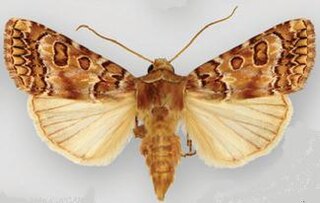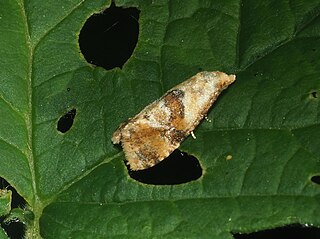Description
It is a relatively large moth that is superficially unlike any other species in North America. It is most closely related to Hypotrix quindiensis (Draudt, 1924) that was originally described as a form of H. lunata; it occurs from Colombia to Peru. Hypotrix lunata differs from H. quindiensis in having a smaller orbicular spot (the two sides of the black mark formed by the fusion of the spots are similar in size in H. quindiensis), the postmedial line is an even black line (an irregular series of black dashes in H. quindiensis ending in a black spot on the costa), the basal line is obscure (a contrasting black spot in H. quindiensis) and the hindwing is fuscous, not dirty white. In the genitalia of H. quindiensis there are two rather than three coils in the vesica and appendix bursae and only the posterior half of the ductus bursae is sclerotized. Hypotrix purpurigera and several of its South American relatives also have black reniform and orbicular spots that are frequently fused posteriorly, creating a wide V-shaped mark. Within the North American fauna the male genitalia of Hypotrix lunata are most similar to those of Hypotrix hueco , but differ in that only the apical part of the uncus is expanded in H. lunata whereas the apical 2/3 is wide in H. hueco, the clasper is stouter and abruptly tapered apically in H. lunata, and the dorsal lobe on the sacculus is much larger. The vesica is very different from that of H. hueco in having much more extensive basal cluster of spines and subbasal cornuti in a longitudinally ribbed basal swelling, and the vesica has three tight medial coils rather than one as in H. hueco. In the female genitalia the appendix bursae has a corresponding three coils to those in the vesica and the ductus bursae is more heavily sclerotized.
The Azelinini are a tribe of geometer moths in the subfamily Ennominae, with many species in the Southern Hemisphere, particularly in South America. Several species are found in North America as well. These stocky geometer moths seem to be closely related to other robust tribes, such as the Campaeini, Ennomini, Lithinini and Nacophorini – all of which might warrant to be subsumed in the Ennomini – the genus Odontopera, and perhaps the Caberini and Colotoini. The tribe was first described by William Trowbridge Merrifield Forbes in 1948.
Bacotoma is a genus of moths in the subfamily Spilomelinae of the family Crambidae. It currently comprises 11 species, with an Oriental and Australasian distribution ranging from India and Sri Lanka over China and Southeast Asia to Australia.
Chrysophyllis is a genus of the grass moth family (Crambidae). It is monotypic, containing the single species Chrysophyllis lucivaga. This moth is very little known, having only been recorded once, before 1935. It belongs to the large grass moth subfamily Spilomelinae; at the time of its description, these were still included in subfamily Pyraustinae and the entire Crambidae was then merged with the snout moths. While its exact relationships are undetermined, it is believed to be a close relative of Talanga. Like these, the male genitalia of C. lucivaga feature a remarkably elongated aedeagus shaped like a bullwhip.

Eugraphe is a genus of noctuid moths. They belong to the tribe Xestiini of the typical noctuid subfamily Noctuinae, though some do not separate this tribe and include the genus in the Noctuini. It is closely related to Anagnorisma, Coenophila and Eugnorisma, and as it seems most closely to the first of these. The geographic range is Palearctic, north of the Alpides but including the Caucasus, and between the Arctic and the arid lands of Central Asia.

Hypotrix is a genus of moths of the family Noctuidae.

Goniographa is a genus of noctuid moths. They belong to the tribe Xestiini of the typical noctuid subfamily Noctuinae, though some do not separate this tribe and include the genus in the Noctuini.

Hypotrix alamosa is a moth of the family Noctuidae first described by William Barnes in 1904. It is known only from the United States in south-eastern Arizona.

Hypotrix hueco is a moth of the family Noctuidae first described by William Barnes in 1904. It is known only from south-eastern Arizona in the United States.
Phereoeca allutella, the household case-bearing moth, belongs to the subfamily Tineinae of the fungus moth family (Tineidae). It was first described by Hans Rebel in 1892. It is an occasional pest of furs, flannel and similar materials, and has been inadvertently introduced to many places it is not originally native to.

Ogdoconta satana is a moth in the family Noctuidae. It is found in western Texas and Carlsbad Caverns National Park in Eddy County, New Mexico. It is probably also present in Mexico.

Macrosoma albida is moth-like butterfly described by William Schaus in 1901. It belongs to the family Hedylidae. Originally it belonged to the genus Hyphedyle.

Macrosoma bahiata is a moth-like butterfly species described by Rudolf Felder and Alois Friedrich Rogenhofer in 1875. It belongs to the family Hedylidae. Originally it belonged to the genus Phellinodes. Malcolm J. Scoble combined it with Macrosoma in 1986.

Macrosoma cascaria is moth-like butterfly described by William Schaus in 1901. It belongs to the family Hedylidae. Originally it belonged to the genus Hyphedyle. Malcolm J. Scoble combined it with Macrosoma in 1986.

Ichneutica pelanodes is a moth of the family Noctuidae. It is endemic to New Zealand and has been found in scattered locations in the North, South and Stewart Islands. I. pelanodes is easily confused with I. skelloni as the two species are visually extremely similar. In the North Island though the range of the two species appears not to overlap. Generally of the two species I. pelanodes tends to be darker in appearance. I. pelanodes inhabits wetlands but the life history of this species is unknown as are the host species of its larvae. Adults are on the wing from October to February and are attracted both to sugar and light traps.

Phalonidia lavana, or Platphalonidia lavana, is a species of moth of the family Tortricidae, the subfamily Tortricinae, and the tribe Cochylini. It has a terrestrial habitat and is found throughout North America. It does not have a Global Conservation Status Rank.
Naarda gigaloba is a moth of the family Erebidae first described by Balázs Tóth and László Aladár Ronkay in 2015. It is found in Sri Lanka.

Lineodini is a tribe of the species-rich subfamily Spilomelinae in the snout moth family Crambidae.
Udeini is a tribe in the species-rich subfamily Spilomelinae in the pyraloid moth family Crambidae. The tribe was erected by Richard Mally, James E. Hayden, Christoph Neinhuis, Bjarte H. Jordal and Matthias Nuss in 2019.
Cheverella is a monotypic genus of snout moths in the subfamily Spilomelinae of the family Crambidae. It contains only one species, Cheverella galapagensis, which is endemic to the Galápagos Islands of Ecuador. Both the genus and the species were first described by Bernard Landry in 2011. The genus is placed in the tribe Udeini.

Phalonidia udana, or the loosestrife conch, is a European species of moth of the family Tortricidae, the subfamily Tortricinae, and the tribe Cochylini. It is widely distributed in the North Palaearctic but appears to be largely rare or missing in Central Europe. Previously, it was classified under the Phalonidia manniana taxon, but a recent effort to barcode all North European Lepidoptera revealed that P. udana and P. mannania are two distinct species.












